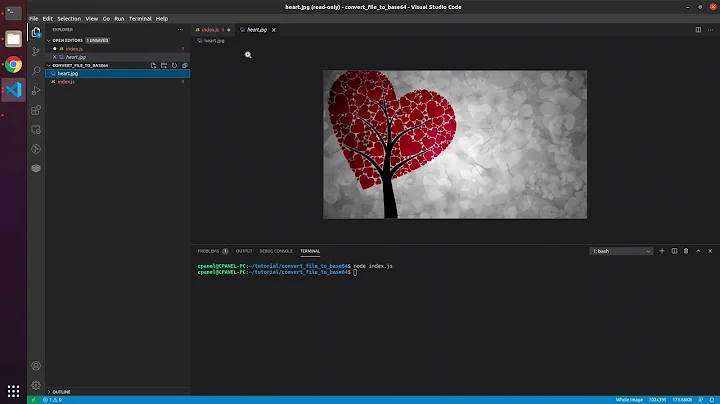How to convert Image PIL into Base64 without saving
Solution 1
I found the solution. Hope this helps !
img = Image.fromarray(data, 'RGB') #Crée une image à partir de la matrice
buffer = BytesIO()
img.save(buffer,format="JPEG") #Enregistre l'image dans le buffer
myimage = buffer.getvalue()
print "data:image/jpeg;base64,"+base64.b64encode(myimage)
Solution 2
@florian answer helped me a lot but base64.b64encode(img_byte) returned bytes so I needed to decode it to string before concatenation (using python 3.6):
def img_to_base64_str(self, img):
buffered = BytesIO()
img.save(buffered, format="PNG")
buffered.seek(0)
img_byte = buffered.getvalue()
img_str = "data:image/png;base64," + base64.b64encode(img_byte).decode()
Solution 3
You can use base64 library like this:
import base64
base64.b64encode(img.tobytes())
See tobytes() method of Image object.
Solution 4
Or you can use something like this:
import glob
import random
import base64
from PIL import Image
from io import BytesIO
import io
def get_thumbnail(path):
path = "\\\\?\\"+path # This "\\\\?\\" is used to prevent problems with long Windows paths
i = Image.open(path)
return i
def image_base64(im):
if isinstance(im, str):
im = get_thumbnail(im)
with BytesIO() as buffer:
im.save(buffer, 'jpeg')
return base64.b64encode(buffer.getvalue()).decode()
def image_formatter(im):
return f'<img src="data:image/jpeg;base64,{image_base64(im)}">'
Just pass path of image in get_thumbnail function and image_formatter to display it in HTML.
Related videos on Youtube
florian
Updated on May 25, 2022Comments
-
 florian almost 2 years
florian almost 2 yearsI generate an image with Python, and I need to convert this Pil Image into a Base64, without saving this one into any folder...
I have some data, and I get RGB img with the line below:
img = Image.fromarray(data,'RGB')What is the simple way to convert this PIL into base64 ?(I can't open a file image because I must not save the img) ?
Thank you for your help
With Node JS, I can get the correct base64 with these lines :
pythonShell= require("python-shell"); app.post('/index/gen/',urlencodedParser, function (req,res){ pythonShell.run('minigen.py', function (err, results) { if (err) throw err; var img = base64img.base64Sync('./images/miniature.jpg'); res.send(img); }); })But I have to save the file if I use NodeJS...
this is the code to generate the matrix from the image, you don't need to know what is in data ;)
image = Image.open("./carte/"+fichier) image = image.resize((400,400),Image.ANTIALIAS) w,h = image.size tab = numpy.array(image) data = numpy.zeros((h, w, 3), dtype=numpy.uint8)-
James Kent over 6 yearsare you sure you want to convert the PIL? i would have thought it would make more sense to convert you
dataarray? -
 florian over 6 yearsI must convert the data into an RGB image.And then convert this image object to base64
florian over 6 yearsI must convert the data into an RGB image.And then convert this image object to base64 -
bv. about 5 yearsPossible duplicate of Is it possible to create encodeb64 from Image object?
-
-
 florian over 6 yearsAfter the conversion into RGB image ? I don't have correct values by doing this
florian over 6 yearsAfter the conversion into RGB image ? I don't have correct values by doing this -
 Tomáš Linhart over 6 years@florian What do you mean by correct values? Base64 just encodes binary data into ASCII characters, which is what you asked for.
Tomáš Linhart over 6 years@florian What do you mean by correct values? Base64 just encodes binary data into ASCII characters, which is what you asked for. -
 florian over 6 yearsOur API also works with nodejs and as we try to do the same thing with it, we can display the image in our navigator... Which is impossible with the base64 that we obtain with your method
florian over 6 yearsOur API also works with nodejs and as we try to do the same thing with it, we can display the image in our navigator... Which is impossible with the base64 that we obtain with your method -
 Tomáš Linhart over 6 yearsWhere do
Tomáš Linhart over 6 yearsWhere dodatainimg = Image.fromarray(data,'RGB')come from and what do they represent? There's a warning regarding compressed formats like JPEG in the documentation toImage.tobytes()method that I referenced in the answer. -
 florian over 6 yearsit's the matrix from the image
florian over 6 yearsit's the matrix from the image -
 Tomáš Linhart over 6 yearsCan you share the part of code that populates that
Tomáš Linhart over 6 yearsCan you share the part of code that populates thatdataobject? -
 Tomáš Linhart over 6 yearsIf
Tomáš Linhart over 6 yearsIfdata = numpy.zeros((h, w, 3), dtype=numpy.uint8)isn't it just all zero? Probably something you didn't want. -
 florian over 6 yearsNo, don't worry, the script make many colors for an altimetric map ;)
florian over 6 yearsNo, don't worry, the script make many colors for an altimetric map ;)





